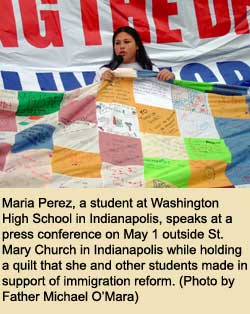‘We are all immigrants’: May 1 Mass, march demonstrate support for immigration reform

By Sean Gallagher
 The nationwide movement for immigration reform continued from coast to coast on May 1 as thousands stayed away from work to take part in “A Day Without Immigrants.”
The nationwide movement for immigration reform continued from coast to coast on May 1 as thousands stayed away from work to take part in “A Day Without Immigrants.”
But in the Catholic Church, May 1 is also the Feast of St. Joseph the Worker, so many Catholic immigrants in the archdiocese marked the day with a special Mass at St. Mary Church in Indianapolis attended by approximately 500 people.
It was preceded by a pilgrimage on the city streets by approximately 150 immigrants and those who support immigration reform. They walked from St. Patrick Parish to St. Mary Parish, two Indianapolis faith communities that many who have moved to this country call their faith home.
Three weeks earlier, a march along the streets of downtown Indianapolis in support of immigration reform began at St. Mary Church. But on May 1, Father Michael O’Mara, pastor of St. Mary Parish, said the emphasis was different.
“We just wanted to have a quiet day where people just stayed home to kind of feel an absence of Hispanics,” he said. “I felt that during the day, not having Hispanics in and out, not even at the regular noon Mass where we always have some Hispanics that are there. It was a very somber day until the evening when we had the Mass, and that was a really beautiful celebration.”
Eva Morales, coordinator of religious education at St. Patrick Parish in Indianapolis, marked the day in a unique way.
“I stopped going shopping,” she said. “I stopped doing the special things that I could have done yesterday since I was not working. I didn’t go out to eat or spend any money at all.”
Although born in the United States, Morales grew up in Mexico and only came back when she married at age 21 in the early 1970s.
She said she hoped that the ongoing movement for immigration reform helps more Americans realize their own ties to those who moved here from another country.
 “I hope that people can understand the point of immigration,” Morales said, “that we are all immigrants and this is a journey that … somebody in our lives, perhaps ancestors, have gone through. It’s nothing new.”
“I hope that people can understand the point of immigration,” Morales said, “that we are all immigrants and this is a journey that … somebody in our lives, perhaps ancestors, have gone through. It’s nothing new.”
Although Morales deliberately stayed away from shops and restaurants throughout the day, ending it with prayer at St. Mary Church with immigrants, and those who support immigration reform, was important to her.
“That prayer gives me the assurance that something is going to happen and whatever happens is what God has for us,” she said. “It’s not like we’re praying to have our way or no way. We’re praying for something that is just in the eyes of God. And if it is what we are meant to have, then that’s what we’re going to have.”
In Mexico and Latin American countries, May 1 is both the civic equivalent to Labor Day in the United States and a religious holiday.
Many who joined Morales in prayer at St. Mary Church were from the Anglo community. Father O’Mara said that this showed the broadness of the movement for immigration reform.
“This is not just a Hispanic movement,” he said. “This is a human movement. There are English speakers, there are Spanish speakers, there are Catholics, there are people of many different faith traditions who are in this movement in order to bring about some kind of just immigration reform.”
Franciscan Father Arturo Ocampo, pastor of St. Patrick Parish in Indianapolis, whose father emigrated from Mexico to the United States in 1919, led the pilgrimage from his parish to St. Mary Parish.
For him, the two-mile walk and the prayers that were made along the way were symbolic of the ongoing struggle for immigration reform.
“We prayed for justice for the immigrants,” Father Arturo said. “And we prayed that the Lord bless us as we continue on our journey … together, no matter what the obstacles may be.”
Before the Mass, Maria Perez, 18, a student at Washington High School in Indianapolis, spoke at a press conference and displayed a quilt that she and other students made that expressed the hopes and dreams of those who have come to America.
“Each little square represented a young person in high school,” Father Arturo said. “I just can’t imagine what that quilt would look like if there were missing parts.”
Father Arturo used a Gospel image to describe the young immigrants who helped make the quilt and all other immigrants to America.
“The immigrant is the salt of the earth,” he said. “These are the people that keep us from rotting. They preserve us in our faith. They preserve us by purifying us of the evil that wants to kind of just creep in and take over.” †

 “I hope that people can understand the point of immigration,” Morales said, “that we are all immigrants and this is a journey that … somebody in our lives, perhaps ancestors, have gone through. It’s nothing new.”
“I hope that people can understand the point of immigration,” Morales said, “that we are all immigrants and this is a journey that … somebody in our lives, perhaps ancestors, have gone through. It’s nothing new.”